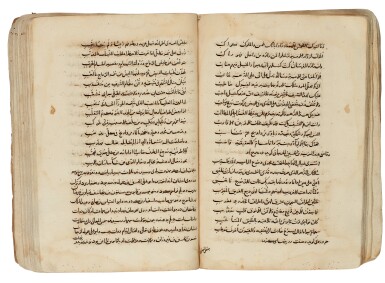
Nasih ibn Zafar al-Jurbadqani, Tarjamah Yamini 'Utbi (on the history of Ghaznavid rulers Sebuktigin and Mahmud of Ghazni), signed by Muhammad ibn Kamray ibn Muhammad ibn Abu'l-Mukhtar, Persia, dated 11 Rajab 711 AH/30 November 1311 AD
Estimate
20,000 - 30,000 GBP
Lot Details
Description
Persian manuscript on paper, 154 leaves, plus 2 flyleaves, 19-21 lines to the page written in naskh in black and brown ink, copied in 2 hands, in brown leather binding
24.6 by 16.8cm.
Ex-collection Jafar Ghazi (d.2007), Munich
This manuscript is an Ilkhanid copy of Nasih ibn Zafar al-Jurbadqani’s translation of Abu Nasr Muhammad ibn Muhammad al-Jabbar al-'Utbi’s Tarikh-i Yamini. The Tarikh-i Yamini is an Arabic history of the Ghaznavid rulers Sebuktigin (r.977-997 AD) and Mahmud of Ghazni until the year 1021, although his entire reign lasted from 998-1030 AD.
Mahmud of Ghazni is one of the most highly recognised Muslim leaders in South Asia, remembered as both an inspired leader and insatiable invader. Upon his ascension at the age of twenty-seven, he sought to transform the small kingdom of Ghazna into a vast empire. His ambition saw him lead a series of successful military expeditions that eventually resulted in an empire that spanned Eastern Iran, Afghanistan and much of Pakistan. In this expansive kingdom, Mahmud of Ghazni was an eminent patron of the arts and many outstanding scholars settled in his capital, notably Ferdowsi, who dedicated his final version of the epic Shahnameh to the ruler.
Although the Tarikh-i Yamini of al-‘Utbi contains numerous incorrect dates and omissions, it is nonetheless an important source on Mahmud of Ghazni’s invasions in the Indian sub-continent. Completed in 1206-07 AD, Al-Jurbadqani’s ‘translation’ significantly embellishes and expands upon al-‘Utbi’s narrative, and includes information on the history of the Seljuks and the Atabegs as well as poetry by the author and others. The author explains in the preface that he completed the text while in the service of the diwan or chancery of the sultan of Azerbaijan, the Eldiguzid Sultan Abu Bakr. For a discussion of the original and al-Jurbadqani’s translation, see Nöldeke 1857.
This early copy of the text is dated 1311 AD, copied just over a hundred years after its composition. It is signed Muhammad ibn Kamrav ibn Muhammad ibn Abi’l-Mukhtar but appears to be copied in two hands. The first hand, which ends on f.27b, makes occasional use of the letter dhal for the letter dal which may indicated a Khurasani origin.
You May Also Like


![An extremely rare illustrated manuscript of the Ka'banameh (A history of the Ka'ba) by Abdulrahman Gubari (d.1566), signed by Ahmad [...] al-Khatib, Kaposvár, Hungary, dated Dhu'l-Hijjah 1080 AH/April-May 1670 AD](https://dam.sothebys.com/dam/image/lot/1e33ac28-a449-4673-a23f-f1ca4d5a13b3/primary/extra_small)







